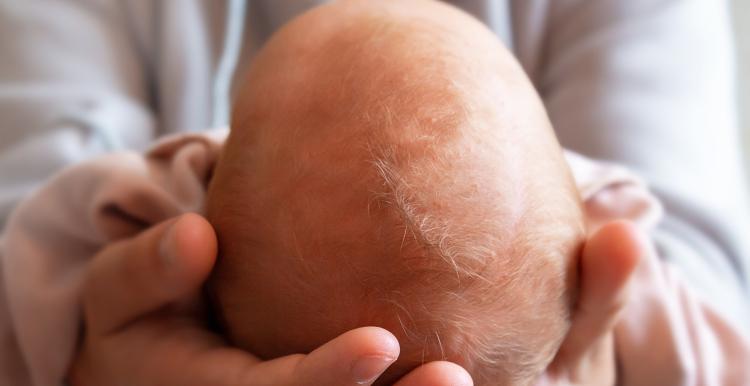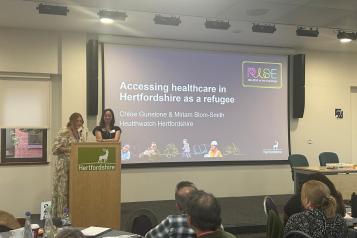Craniosynostosis

Recognising the Symptoms
It is important to recognise craniosynostosis early, to ensure treatment is delivered at the correct time. Depending on the type of craniosynostosis and treatment required, this could be an early surgery when the child is below 6 months of age, or a later surgery between 18-24 months old.
The signs of craniosynostosis vary depending on which suture is affected, but common features include:
- Unusual head shape – flattening, asymmetry, or elongation of the skull.
- Raised or ridged sutures – a hard ridge along the skull where bones have fused too soon.
- Facial asymmetry – unevenness of the eyes, ears, or jaw alignment.
- Bulging or misshapen forehead – sometimes one side may appear more prominent.
- Problems with head growth – the head may not grow as expected, or growth may plateau early.
In some children, craniosynostosis is part of a wider syndrome (e.g., Apert, Crouzon, Pfeiffer syndromes), which may also involve differences in the hands, feet, or midface.
Physical, Psychological, and Social Impacts
While the medical consequences can include raised intracranial pressure or developmental delays, craniosynostosis can also affect self-esteem, social interaction, and mental well-being for both the child and family—especially when visible features prompt misunderstanding or unwanted attention.
Why Specialist Hospitals Matter
In the UK there are four Highly Specialised Craniofacial Units in England and one in Scotland. These are the only centres with the expert teams needed to diagnose and treat craniosynostosis safely.
Most of these units accept direct GP referrals, so families should ask to be referred straight to a specialist centre. Going first to a local hospital can cause delays and, in some cases, unnecessary stress. Early referral ensures children are seen quickly by the right specialists.
Why Craniosynostosis Remains Under the Radar
Rarity and Variability
Affecting approximately 1 in every 1,800 to 2,000 babies in the UK, craniosynostosis can be either non-syndromic (involving a single suture and often isolated to head shape) or syndromic (involving additional physical features and often a genetic cause). Its low incidence and wide variation in presentation can delay recognition and diagnosis.
Limited Awareness Among Healthcare Professionals
Many healthcare providers encounter very few cases, which means early signs—especially in mild or atypical presentations—may be overlooked. Awareness among professionals varies, contributing to potentially delayed referrals for specialist care.
Personal Testimony
"My son was born with metopic craniosynostosis. From birth, I raised concerns about his headshape with several professionals but each time I was dismissed. Finding the craniofacial charity Headlines was a lifeline: they provided the information I needed to explain the condition and referral pathway to my GP. I learned that surgery was essential before the age of 18 months to prevent intracranial pressure and irreversible complications.
"The greatest stress came from battling for a referral before time ran out. Even with evidence from Headlines, my concerns were repeatedly dismissed. Eventually, I secured the referral: the relief was immeasurable. The specialist craniofacial team reassured me we were in safe hands, though major skull reconstruction loomed.
"The surgery was successful, and my son recovered astonishingly well. Twelve years on, he is thriving. I remain deeply grateful to the craniofacial team who cared for him and continue his check-ups."
Fiona Corcoran, Healthwatch Hertfordshire Deputy CEO
Headlines: Leading the Way in Awareness, Support, and Research
Headlines is the UK’s leading charity offering support, information, and advocacy for individuals and families affected by craniosynostosis and other rare craniofacial conditions.
Their core activities include:
- Support for life’s journey — Guidance tailored to all stages, from infancy to adulthood, including counselling and psychological support.
- Raising awareness and educating — Campaigns and resources designed to improve understanding among the public and healthcare professionals.
- Facilitating research — Actively supporting efforts to improve diagnosis, treatment, and long-term outcomes.
Spotlight on Innovation in Treatment
In many cases, optimal treatment remains skull reconstruction surgery, between 1-2 years of age.
However, in recent years, surgical interventions have advanced significantly, making real-time preoperative planning more essential than ever. In many cases at Great Ormond Street Hospital, for instance, spring-assisted cranioplasty (SAC) is used to correct sagittal craniosynostosis, though outcomes can vary depending on surgeon experience and patient age. Promising new research incorporates machine learning models leveraging 3D-photogrammetry to reduce radiation exposure and improve predictability in surgical planning.
Conclusion and Call to Action
Craniosynostosis is a rare but impactful condition that unfortunately remains too often overlooked. Raising awareness—among medical professionals, families, and the wider community—is essential to ensure early diagnosis, timely intervention, and holistic support.
Headlines exemplify how education, peer support, professional guidance, and advocacy can transform outcomes for those affected. With continued effort, increased visibility, and investment in innovation, we can move closer to a future where craniosynostosis is swiftly addressed, and every family receives the comprehensive care they deserve.
Further Resources
To learn more about craniosynostosis, access help from Headlines, or explore how to support or get involved, visit: Headlines Craniofacial Support | Charity | United Kingdom.


